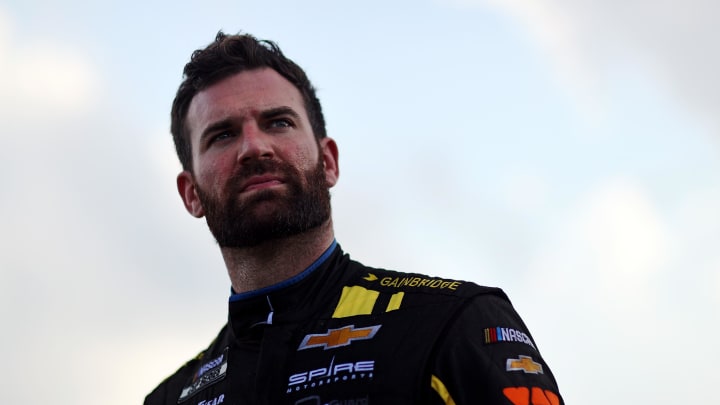LaJoie Suspects New Air Jack System Led to Michigan Flip

In an interview with SiriusXM NASCAR Radio's On Track on Wednesday, Corey LaJoie spoke at length about his weird, and scary flip in Monday's NASCAR Cup Series FireKeepers Casino 400 at Michigan International Speedway. LaJoie described that when he first kicked sideways after making contact with Noah Gragson, he was mentally preparing to drive his car back to pit road for fresh tires. Less than a second later, he knew he had bigger problems.
"It was in fast forward. I had enough time from initial contact, where I was sliding, I'm like, 'Okay, damn it, you spun out, let's hope we don't have flat spots. Let's try to get it back to the pits and put tires on it.' And in the three-tenths of a second I was thinking that, I'm like, 'Oh, I'm upside down. There's no driving out of this one,'" LaJoie recalled.
LaJoie's crash at Michigan, a track not often known for blow-over crashes, has sparked a lot of debate about the NASCAR Next Gen car and whether the car is too prone to flipping. The No. 7 Spire Motorsports Chevrolet driver issued his theory on why his race car lifted off the ground so easily in the crash.
This is so, so bizarre. #NASCAR pic.twitter.com/85lMak7r0q
— Toby Christie (@Toby_Christie) August 19, 2024
The 32-year-old believes the optional air jack system that NASCAR allowed teams to install at Michigan to aid cars with flat tires stuck on the race track caused the imbalance that sent his car flying.
RELATED: NASCAR Allows Teams to Add Lift System to Aid in Flat-Tire Situations
"So, I have a theory. I'm probably going to go to the R&D Center and just see if my theory might be accurate about those air jacks potentially letting the right rear tire droop and the car getting up and getting to a platform where the liftoff speed is slower," LaJoie explained. "So, I don't know, but we haven't seen one by itself flip right over like that in a while. So, I'm sure those guys are looking at it."
LaJoie, who is the son of two-time NASCAR Xfinity Series champion Randy LaJoie, was one of the drivers in the field who was wearing a data gathering mouthpiece, which helps NASCAR detect how many g-forces drivers are being subjected to in on-track incidents. While the flip was spectacular, the impacts LaJoie sustained didn't seem to aggressive. Even so, his crash still registered g-forces of 30 gs.
"Well, I don't like being the one gathering it. I wish other people would gather it, then I would be the recipient of their data, rather than my own mouthpiece sensor data," LaJoie joked about his mouthpiece data. "But unfortunately, I've been doing that too often with how the year has went. You know, having the mouthpiece sensor data, that was only about a 30 [g] -- there was one or two instances of 30 gs. But I think it looks worse than what it was. You know, 30 gs it's not nothing, it hurts, and it makes you a bit sore. Flipping through the grass is where it happened."
On Wednesday, LaJoie also shared in-car video from his crash, which shows just how violently the driver was shaken around in the cockpit of his car, when the No. 7 Chevrolet hit the grass patch in Turn 3, which sent the car barrel rolling back onto its wheels.
“Hey, can I ride in the passenger seat with you?” - fans pic.twitter.com/2Ahe9yvS67
— Corey LaJoie (@CoreyLaJoie) August 21, 2024
While the driver took g-force loads of around 30 in a couple of instances of the crash, LaJoie says the g-forces registered by his actual car were lower than the totals gathered by his mouthpiece data. LaJoie says the difference in the numbers is based around his head bouncing around between the headrests in the car.
"The car saw a little bit less gs than that, so it's just from your head smacking between the headrests of where you see a bit more g-load on the mouthpiece versus the car," LaJoie said. "That's potentially a little bit softer foam, a little bit tighter gap, things like that so you don't get the inertia of your head bouncing back and forth."
This weekend, the NASCAR Cup Series heads to Daytona International Speedway, the site of Ryan Preece's frightening barrel roll flip on the backstretch last season. After experiencing his second flip of the season, LaJoie also flipped in a final lap crash at Talladega Superspeedway in April, the driver says he has no fear about flipping again this weekend in the back of his head.
Instead, LaJoie is focused on doing whatever he can to put himself in a position to score a surprise win to lock him, and his No. 7 Spire Motorsports team into the NASCAR Cup Series Playoffs.
"That's also the risk you lay. You know you have to put yourself in harms way to get the ultimate reward. You know, it's Daytona for us, and guys outside the Playoffs. This is the highest risk, and highest reward place we go to," LaJoie stated. "I'm willing, like I am every Sunday, to assume that risk, tighten the belts and see if I can't get our Celsius Camaro in contention to steal a win."
With two races remaining until the start of the NASCAR Cup Series Playoffs, LaJoie sits 31st in the NASCAR Cup Series championship standings and is mathematically unable to work his way into a Playoff berth by way of points. However, a win this weekend or next weekend at Darlington Raceway could completely flip (no pun intended) the script on his disappointing final season with Spire Motorsports.
